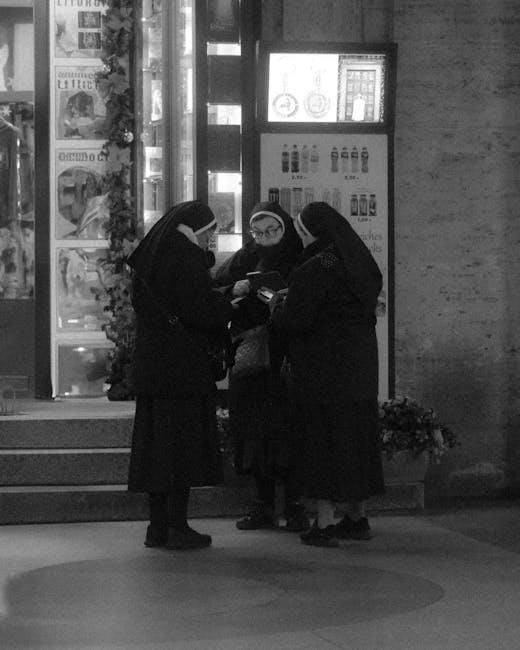The Order of Christian Initiation of Adults (OCIA) is the formal process by which adults are welcomed into the Catholic Church through sacramental initiation.

1.1 Purpose and Overview of the OCIA Process
The Order of Christian Initiation of Adults (OCIA) is a structured journey designed to guide adults in their conversion to Catholic Christianity. Its primary purpose is to foster spiritual growth‚ deepen faith‚ and prepare individuals for the sacraments of Baptism‚ Confirmation‚ and Eucharist. The process is divided into distinct periods: Inquiry‚ Catechumenate‚ Enlightenment‚ and Mystagogia. Each phase is marked by liturgical rites and catechetical instruction‚ ensuring a comprehensive and transformative experience. The OCIA emphasizes community support‚ prayer‚ and reflection‚ leading participants toward full initiation into the Church.
1.2 Historical Background and Development
The Order of Christian Initiation of Adults (OCIA) traces its roots to early Christian practices‚ where adults underwent a gradual process of conversion. Formalized in 1972‚ the OCIA was established to restore the ancient catechumenate‚ adapting it to modern needs. It draws inspiration from the early church’s initiation rites‚ emphasizing spiritual formation and liturgical celebration. The process has evolved over centuries‚ influenced by liturgical reforms and theological developments. Its current structure reflects a deep understanding of faith journey‚ ensuring a comprehensive path to sacramental initiation and full membership in the Catholic Church.
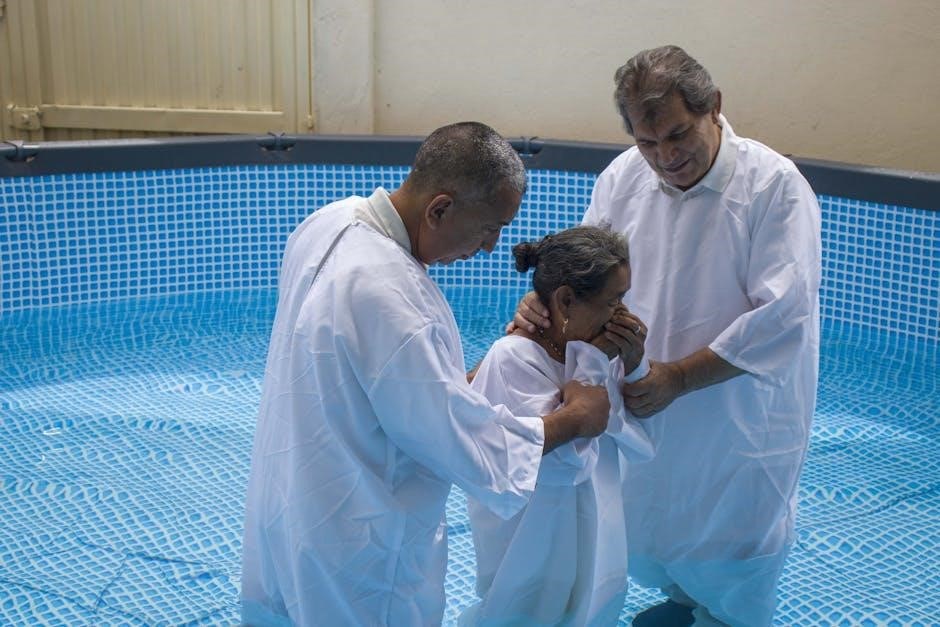
The Period of Inquiry
The Period of Inquiry is the initial stage where individuals explore their faith‚ building trust and understanding of Christianity‚ guided by the Church community.
2.1 The Purpose of the Initial Conversion
The initial conversion in the OCIA process aims to awaken faith and inspire a deeper spiritual curiosity in inquirers‚ helping them recognize God’s call to follow Christ.
2.2 Building Trust and Faith in the Inquirers
Building trust and faith during the inquiry period involves creating a welcoming environment where individuals feel comfortable exploring their spiritual questions. Sponsors and catechists play a vital role by sharing personal testimonies and fostering meaningful connections. This phase emphasizes listening‚ prayer‚ and introducing the basics of Christian teachings to help inquirers deepen their understanding of God’s love and their place in the Church community‚ fostering a sense of belonging and spiritual growth.
2.3 Liturgical Rites for the Inquirers
Liturgical rites for inquirers are sacred ceremonies that mark their spiritual journey. The Rite of Welcome and the Rite of Acceptance are key rituals‚ symbolizing their transition from curiosity to commitment. These rites involve blessings‚ prayers‚ and processionals‚ emphasizing God’s call and the community’s support. They are celebrated during Mass‚ integrating the inquirers into the Church’s liturgical life and deepening their faith. These moments are pivotal‚ fostering a sense of belonging and spiritual growth as they progress toward full initiation.

The Period of the Catechumenate
The Catechumenate is a time of deeper formation‚ focusing on spiritual growth and catechesis. It involves regular instruction‚ prayer‚ and participation in liturgical celebrations‚ fostering a stronger faith foundation.
3.1 Formation and Catechesis
During the Catechumenate‚ formation and catechesis are central‚ providing in-depth instruction on Catholic teachings‚ sacraments‚ and moral life. This period emphasizes spiritual growth‚ prayer‚ and community involvement‚ ensuring a strong foundation in the faith. Regular sessions with catechists and participation in liturgical rites help deepen understanding and commitment. The process is tailored to meet the needs of each individual‚ fostering a personal connection with Christ and the Church.
3.2 The Rite of Acceptance into the Order of Catechumens
The Rite of Acceptance marks the transition from the Period of Inquiry to the Catechumenate. It is a liturgical celebration where inquirers publicly express their intention to continue their faith journey. Through prayer and the signing of the senses‚ they are formally accepted into the Order of Catechumens. This rite signifies the Church’s recognition of their commitment and serves as a pivotal moment of grace‚ deepening their resolve to follow Christ. Sponsors and the community offer support‚ affirming their journey toward full initiation.
3.3 Celebrations of the Word and Preaching
Celebrations of the Word and Preaching are integral to the Catechumenate‚ focusing on deepening the catechumens’ understanding of Scripture and fostering their spiritual growth. These liturgical gatherings emphasize the proclamation of the Word‚ followed by homilies and reflections tailored to the catechumens’ journey. The dismissal rite‚ where catechumens are invited to reflect on the Word‚ underscores the Church’s role in nurturing their faith. This phase aligns with the Liturgical Year‚ ensuring catechesis is rooted in the Church’s seasonal celebrations and traditions.

The Period of Enlightenment
The Period of Enlightenment is a time of deep spiritual reflection and preparation‚ focusing on prayer and purification‚ as catechumens prepare to receive the sacraments of initiation.
4.1 Deepening Spiritual Preparation
During the Period of Enlightenment‚ spiritual preparation intensifies through prayer‚ reflection‚ and meditation. Catechumens focus on deepening their faith‚ understanding the mysteries of Christ‚ and embracing the teachings of the Church. This period emphasizes purification of heart and mind‚ aligning their lives with the Gospel values. It is a time to strengthen their resolve to follow Christ and prepare for the sacraments of initiation‚ marking their full entry into the Catholic Church.
4.2 The Scrutinies and Their Significance
The Scrutinies are communal prayers of exorcism and intercession‚ typically celebrated during Lent. They are a spiritual purification process for catechumens‚ helping them overcome sin and deepen their conversion. These rites emphasize self-reflection‚ repentance‚ and enlightenment. The Scrutinies are not a judgment but a grace-filled moment to strengthen the catechumens’ resolve to follow Christ. They are a significant step in their journey toward the Easter sacraments‚ marking their final preparation for Baptism‚ Confirmation‚ and Eucharist.
4.3 The Presentations of the Creed and the Lord’s Prayer
The Creed and the Lord’s Prayer are presented to catechumens during the Period of Enlightenment. The Creed summarizes the core beliefs of Christianity‚ while the Lord’s Prayer embodies Jesus’ teachings on prayer. These presentations deepen the catechumens’ understanding of faith and worship. The Creed is recited during liturgical celebrations‚ reinforcing their commitment to the Church’s teachings. The Lord’s Prayer‚ taught by Jesus‚ becomes a daily prayer for the catechumens‚ fostering a personal relationship with God. These presentations are vital for their spiritual growth and sacramental preparation.
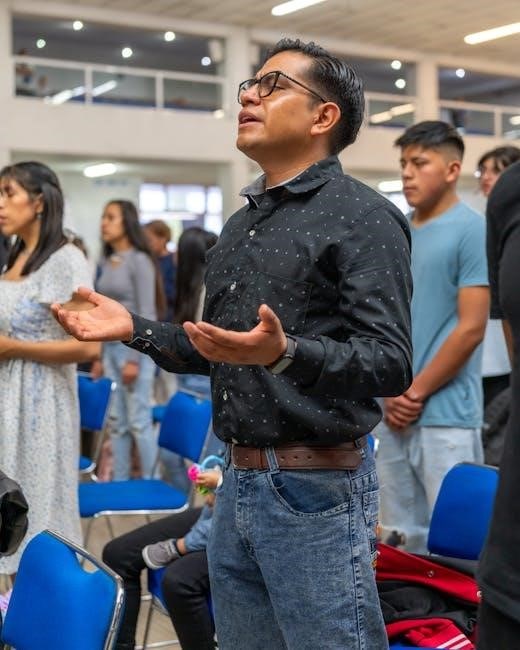
The Easter Vigil and the Sacraments of Initiation
The Easter Vigil is the culmination of the OCIA process‚ where adults receive Baptism‚ Confirmation‚ and Eucharist‚ fully initiating them into the Catholic Church.
5.1 Baptism‚ Confirmation‚ and Eucharist
Baptism‚ Confirmation‚ and Eucharist are the cornerstone sacraments of Christian initiation. Baptism cleanses from sin and rebirths in Christ. Confirmation strengthens faith with the Holy Spirit. The Eucharist unites the initiate with Christ and the Church. These sacraments‚ typically received during the Easter Vigil‚ mark full initiation into the Catholic Church‚ fulfilling the journey of faith and transforming the individual into a living member of Christ’s body. The Eucharist is central‚ nourishing the soul for ongoing discipleship and community life.
5.2 The Rite of Reception of Baptized Christians
The Rite of Reception of Baptized Christians is a sacred ceremony for those already baptized in another Christian tradition. This rite includes a profession of faith‚ Confirmation‚ and the Eucharist‚ uniting them fully with the Catholic Church. It is a simpler process than the full OCIA journey‚ acknowledging their existing baptism while completing their initiation. The Eucharist is central‚ symbolizing their new life in the Church. This rite is often celebrated during the Easter Vigil‚ emphasizing the joy of unity and spiritual renewal.
5.3 The Celebration of the Sacraments at the Easter Vigil
The Easter Vigil is the pinnacle of the OCIA journey‚ where adults receive the sacraments of Baptism‚ Confirmation‚ and the Eucharist. The celebration begins with the Service of Light‚ symbolizing Christ’s resurrection. The Easter Candle is lit‚ and the Exsultet is sung‚ proclaiming the victory of light over darkness. The sacraments are administered in a joyful and solemn liturgy‚ marking the candidates’ full initiation into the Church. This night is a time of profound spiritual renewal and celebration for the newly initiated and the entire faith community.
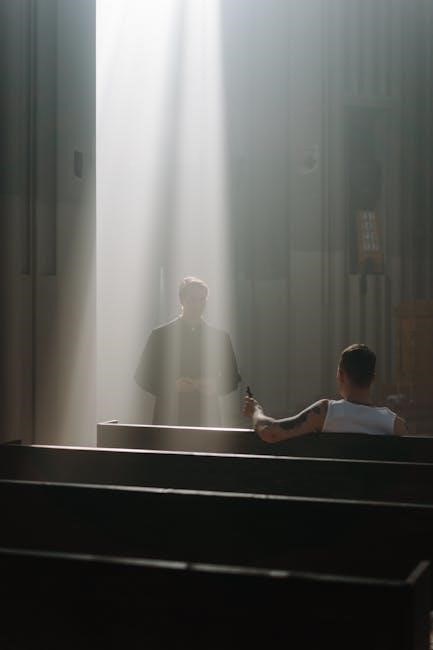
The Period of Mystagogia
Mystagogia is a post-baptismal period of reflection and deepening faith‚ helping newly initiated adults integrate into the Church community through continued catechesis and spiritual growth.
6.1 Post-Baptismal Catechesis and Reflection
Mystagogia is a post-baptismal period of reflection and deeper spiritual growth. It involves continued catechesis to help the newly baptized integrate their faith into daily life. Through prayer‚ scripture‚ and community support‚ individuals deepen their understanding of the sacraments and their role in the Church. This phase emphasizes living as disciples of Christ‚ fostering a lifelong commitment to faith and service. The focus is on spiritual maturity and active participation in the Church community‚ guiding the newly initiated to embrace their mission as baptized believers.
6.2 Integrating the Newly Initiated into the Church Community
Following baptism‚ the newly initiated are welcomed as full members of the Church. The community plays a vital role in supporting their spiritual journey through ongoing formation and fellowship. Parish involvement‚ such as participating in liturgical celebrations and ministries‚ helps deepen their sense of belonging. Sponsors and mentors continue to guide them‚ fostering a lifelong commitment to faith. This integration ensures that the newly baptized are not only initiated but also actively engaged in the life and mission of the Church‚ living as disciples of Christ.
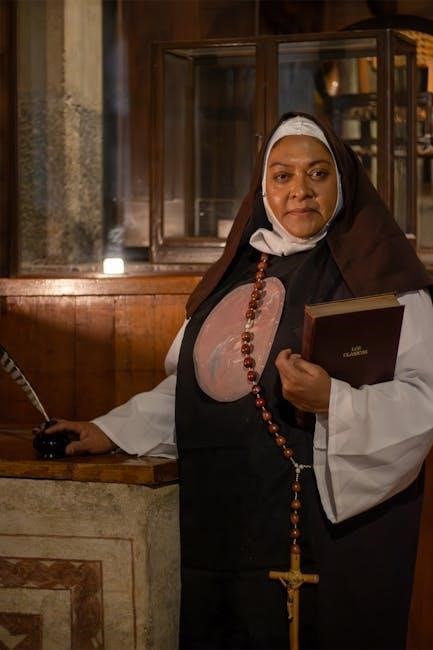
Key Rites and Rituals in the OCIA Process
The OCIA process includes essential rites like the Rite of Welcome‚ Rite of Acceptance‚ and Scrutinies‚ which mark spiritual milestones. These rituals symbolize the journey toward full initiation and deepen the connection with the Church community.
7.1 The Rite of Welcome
The Rite of Welcome is a significant ritual in the OCIA process‚ marking the transition of inquirers into the catechumenate. It is typically celebrated during Mass‚ where the bishop or pastor blesses and welcomes the candidates. This rite symbolizes the Church’s acceptance of their intention to pursue initiation. The catechumens are then dismissed from Mass to reflect on the Word of God‚ emphasizing their new role as learners of the faith. This rite is a powerful step in their spiritual journey‚ supported by the prayers of the community.
7.2 The Rite of Sending
The Rite of Sending is a liturgical celebration that marks the transition of catechumens from their parish community to the Easter Vigil. It involves prayers of blessing and sending forth‚ signifying the catechumens’ readiness to receive the sacraments of initiation. The rite typically occurs in the parish church‚ after which the catechumens are sent to the cathedral or designated place for the Easter celebration. This rite emphasizes the communal aspect of the journey and the support of the parish in their spiritual preparation.

Pastoral Considerations and Best Practices
Pastoral care involves creating a supportive environment for inquirers‚ emphasizing spiritual guidance‚ and fostering community involvement to ensure a personalized and meaningful journey through the OCIA process.
8.1 The Role of Sponsors and the Community
Sponsors play a vital role in the OCIA process by providing spiritual support and guidance to inquirers. They share their faith experiences‚ accompany candidates during rites‚ and help integrate them into the Church. The broader community also contributes through prayer‚ hospitality‚ and active participation in liturgical celebrations. This collective involvement fosters a sense of belonging and ensures that the journey of initiation is both personal and communal‚ rooted in the Church’s mission to evangelize and nurture new members.
8.2 Adapting the Process for Diverse Needs
The OCIA process must be adaptable to meet the diverse needs of inquirers‚ ensuring accessibility for individuals with varying cultural‚ language‚ or developmental backgrounds. pastors and catechists are encouraged to tailor formation sessions‚ using visual aids‚ small group discussions‚ or bilingual resources to accommodate different learning styles. The liturgical rites and catechesis should be sensitive to cultural traditions while maintaining the integrity of Church teachings. This adaptability ensures that the initiation journey is inclusive and meaningful for all‚ fostering a deeper connection to the faith.

The Importance of Liturgical Formation
Liturgical formation is essential for integrating inquirers into the Church’s life‚ fostering a deep understanding of sacraments and rituals through participation and reflection.
9.1 The Role of the Liturgical Year
The Liturgical Year serves as a sacred framework for OCIA‚ guiding participants through seasons like Advent and Lent‚ which deepen spiritual reflection and connection to Christ’s life.
9.2 Celebrations and Rituals
Celebrations and rituals in the OCIA process are essential for fostering spiritual growth and community connection; Key rites‚ such as the Rite of Acceptance and the Rite of Sending‚ mark significant milestones in the journey of adults preparing for initiation. These liturgical moments are deeply symbolic‚ creating a sense of belonging and faith commitment. The Easter Vigil‚ where sacraments are celebrated‚ is the culmination of this sacred journey. These rituals embody the Church’s tradition and provide a profound experience of conversion and renewal. They are integral to the OCIA’s transformative power.
The OCIA journey culminates in a profound transformation‚ guiding adults to embrace their faith deeply and integrate fully into the Church community‚ fulfilling the Church’s mission of evangelization and fostering lifelong spiritual growth.
10.1 The Journey of Faith and Transformation
The OCIA process is a deeply transformative journey‚ guiding adults from initial curiosity to full sacramental initiation. It fosters spiritual growth through prayer‚ reflection‚ and community engagement‚ culminating in the Easter Vigil. The rites and rituals‚ such as the Rite of Acceptance and Scrutinies‚ mark pivotal moments of conversion. This journey not only enriches personal faith but also integrates individuals into the Church‚ empowering them to live as disciples of Christ. The process reflects the Church’s mission to evangelize and nurture believers‚ ensuring a lifelong commitment to faith and service.
10.2 The Ongoing Mission of the Church
The OCIA process embodies the Church’s missionary mandate to evangelize and nurture faith. By initiating adults into the Catholic Church‚ the OCIA ensures the continued growth of the Body of Christ. The Church’s mission is fulfilled through the sacraments‚ catechesis‚ and community integration. This process not only welcomes new members but also empowers them to share the Gospel‚ fostering a vibrant and dynamic faith community. The OCIA reflects the Church’s enduring commitment to spreading the Good News and building a faith-filled future for all generations.
